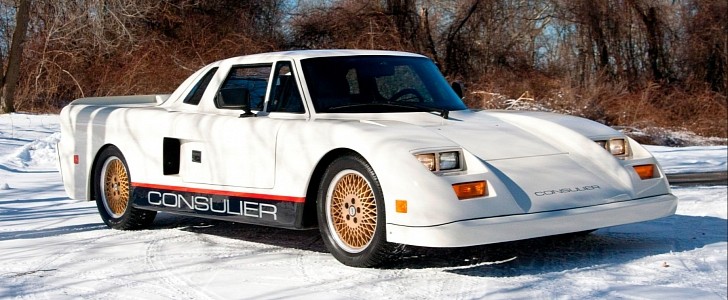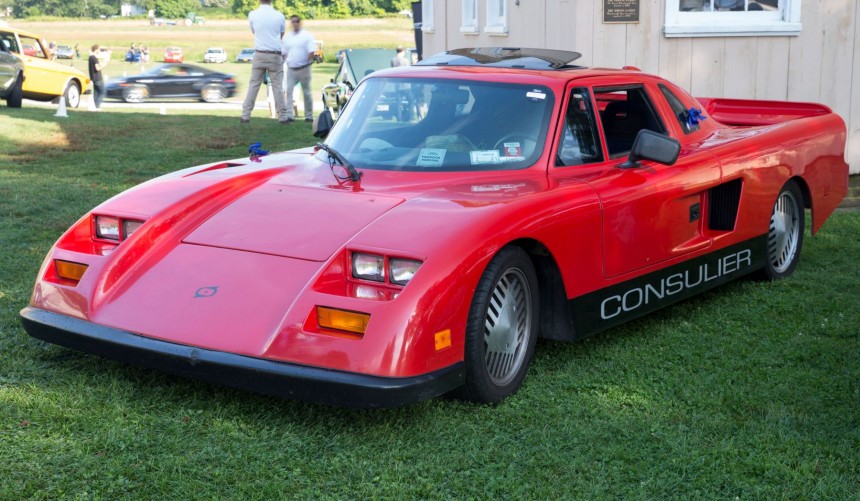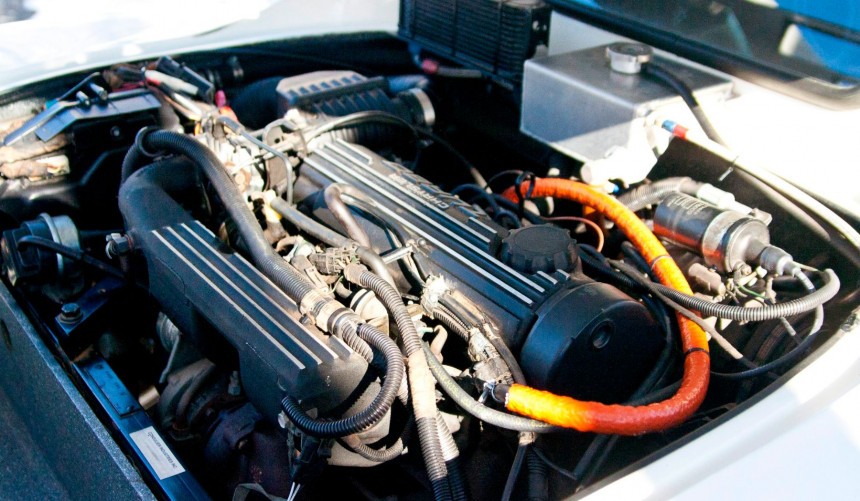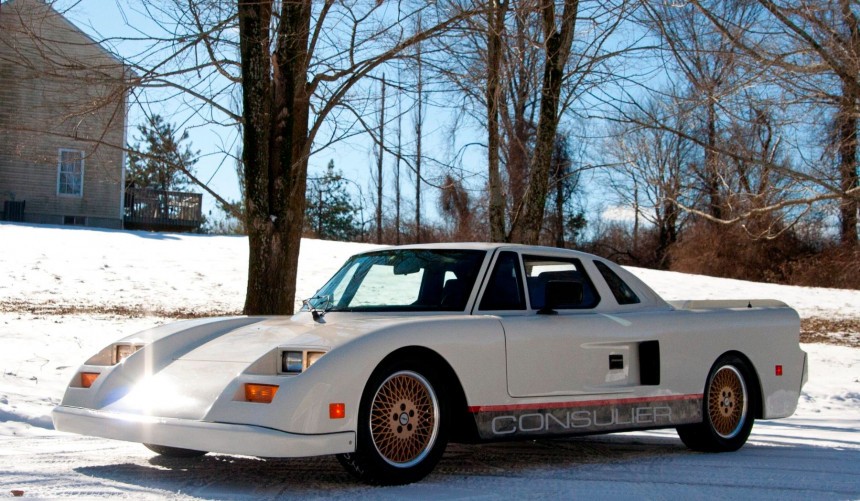Today, there’s no shortage of ultra-lightweight track-oriented supercars. Almost every respectable manufacturer offers at least one. However, the story was much different in the late-1980s when such vehicles were extremely rare.
While America’s big automotive corporations were beginning to recover from the energy crises of the 1970s, bringing back the muscle and developing faster, more capable sports cars, a hedge fund manager named Warren Mosler decided to go in a completely new direction and build one of the quirkiest yet innovative machines of the decade.
Unlike other extremely rich individuals, Mosler didn’t just collect cars but enjoyed racing them. Almost every weekend, he hung up his suit and took a modified VW Rabbit (Golf) GTI to the track. After one of these amateur races, he met Benjamin ‘Dick’ Respess, an emergency room doctor from Texas with a passion for lightweight cars which boasted about being able to build a feather-light non-metal monocoque around his GTI.
Mosler was intrigued, agreed to finance the project and the doctor amazingly delivered, constructing it using nothing but ordinary tools and his acute instinct. The result was not pretty but extremely rigid and aerodynamically efficient, which is outstanding considering no computer analyses or wind tunnel tests were performed.
From there on, the story gets murky. We don’t know exactly what happened to this initial chassis, but legend has it that it was eventually fitted with a Mazda rotary engine and a Porsche 914 gearbox.
What we do know for sure is that Molster was so hooked on the idea of developing a lightweight road-legal car that he assembled a team of experts, built a facility in Riviera Beach, Florida, and founded Consulier Industries in 1985.
After three years of trial and error, the company created an outstanding vehicle named Grand Touring Prototype (GTP), a name inspired by IMSA’s purpose-built endurance race cars of the era. It was undoubtedly ugly since Molster never hired a designer to refine its looks, but more importantly, it was a ground-breaking piece of engineering.
The chassis was a bespoke fiberglass-and-foam monocoque that stood on front and rear steel subframes, while the body panels were made exclusively out of carbon fiber and Kevlar, making it the first production car in the world with no structural metal in the body. For the suspension design, Molster hired IndyCar experts McKee Engineering who worked wonders with parts sourced from a Dodge Daytona Shelby Z.
The aforementioned car also provided the powertrain. Since low weight was the main goal, a heavy V8 was out of the question, so the Chrysler 2.2-liter Turbo II inline-4 was the perfect solution. Mounted behind the cockpit and linked to a 5-speed manual, it was small, light, and produced 175 hp (130 kW), which was more than enough for the 2,200-pound (998 kg) GTP. It could accelerate from 0 to 60 mph (0-97 kph) in 5.2 seconds and reach a top speed of around 149 mph (240 kph).
The car was made available to the general public starting with the 1989 model year. It could be brought in a standard trim called Sport or the more luxurious LX which came with Recaro bucket seats, VDO performance instrumentation, Fittipaldi aluminum wheels, an Alpine sound system, leather upholstery, wool carpeting, air conditioning, cruise control, power locks, power mirrors, power windows, and a fully adjustable steering wheel.
As you would expect, the GTP was also taken to the track, entering many IMSA- and SCCA-sanctioned events throughout the country in the late 1980s and early 1990s. From 1988 to 1990, it won the Nelson Legends 24-hour race, and it would have probably crossed the finish line first in the following years, but was banned from participating after the 1990 triumph.
After building several copies, Consulier released a revised version called Series II. It featured minor aesthetic improvements, but more importantly, it used an upgraded 190-hp Turbo II engine that reduced the 0 to 60 mph (0-97 kph) time to 5 seconds and improved the top speed to 155 mph (249 kph). Also available, was an optional Turbo III unit that could spit out 220 hp, but only a hand full of GTPs were built in this configuration.
In 1991, the company forged a partnership with Shelby American, crating the ultra-rare Consulier C4. With a Turbo III powerplant tuned by Carroll Shelby and his team to produce 245 hp, this road-legal track monster could sprint from 0 to 60 mph (0-97 kph) in a mind-blowing 3.9 seconds. It was fitted with a lightweight dry-cell battery, Yokohama A008R track tires but also offered creature comforts like an Alpine stereo system, air conditioning, and even a decent storage compartment.
Another interesting part of the GTP story was the $25,000 challenge issued by Mosler in 1991. He was so confident about the car’s performance that he offered this large amount of money to anyone who could achieve a better lap time in a street-legal production car on any U.S. racetrack.
Car and Driver magazine accepted the challenge and in 1991, they raced a brand-new Corvette against a 1988 GTP around the Chrysler proving grounds test track in Chelsea, Michigan. The ‘Vette was almost two seconds faster, but Mosler refused to pay, rightfully arguing that the test was dishonest. The magazine used an older, beat-up model which was borrowed from a Track Time driver's school with worn tires and brake pads.
The Consulier boss asked for a ‘rematch’ using a new 1991 model, but Car and Driver refused and ultimately published a road test article where they ridiculed the car.
In the years that followed, the company was rebranded to Mosler Automotive and the GTP morphed into the Mosler Intruder and Raptor, two dramatically improved versions that now used Chevy V8s tuned by John Lingenfelter.
Today, it is estimated that somewhere between 60 and 100 Consulier GTPs were built between 1988 and 1993. The vast majority of them were heavily modified, so only a handful survived in factory spec. One of these surviving models was test driven by BulletmotorsportsInc and you can watch the video they posted on YouTube below. Another example in perfect shape that is featured in the gallery was sold on bringatrailer.com in 2018 for $55,000.
Although it’s considered the ugly duckling of American supercars, the GTP was one of the most insane vehicles of its era. An innovative U.S.-built lightweight track monster that you could drive on public roads, the car deserves more respect, especially since it was the first model built by a small company with no prior experience.
Unlike other extremely rich individuals, Mosler didn’t just collect cars but enjoyed racing them. Almost every weekend, he hung up his suit and took a modified VW Rabbit (Golf) GTI to the track. After one of these amateur races, he met Benjamin ‘Dick’ Respess, an emergency room doctor from Texas with a passion for lightweight cars which boasted about being able to build a feather-light non-metal monocoque around his GTI.
Mosler was intrigued, agreed to finance the project and the doctor amazingly delivered, constructing it using nothing but ordinary tools and his acute instinct. The result was not pretty but extremely rigid and aerodynamically efficient, which is outstanding considering no computer analyses or wind tunnel tests were performed.
From there on, the story gets murky. We don’t know exactly what happened to this initial chassis, but legend has it that it was eventually fitted with a Mazda rotary engine and a Porsche 914 gearbox.
What we do know for sure is that Molster was so hooked on the idea of developing a lightweight road-legal car that he assembled a team of experts, built a facility in Riviera Beach, Florida, and founded Consulier Industries in 1985.
The chassis was a bespoke fiberglass-and-foam monocoque that stood on front and rear steel subframes, while the body panels were made exclusively out of carbon fiber and Kevlar, making it the first production car in the world with no structural metal in the body. For the suspension design, Molster hired IndyCar experts McKee Engineering who worked wonders with parts sourced from a Dodge Daytona Shelby Z.
The aforementioned car also provided the powertrain. Since low weight was the main goal, a heavy V8 was out of the question, so the Chrysler 2.2-liter Turbo II inline-4 was the perfect solution. Mounted behind the cockpit and linked to a 5-speed manual, it was small, light, and produced 175 hp (130 kW), which was more than enough for the 2,200-pound (998 kg) GTP. It could accelerate from 0 to 60 mph (0-97 kph) in 5.2 seconds and reach a top speed of around 149 mph (240 kph).
As you would expect, the GTP was also taken to the track, entering many IMSA- and SCCA-sanctioned events throughout the country in the late 1980s and early 1990s. From 1988 to 1990, it won the Nelson Legends 24-hour race, and it would have probably crossed the finish line first in the following years, but was banned from participating after the 1990 triumph.
After building several copies, Consulier released a revised version called Series II. It featured minor aesthetic improvements, but more importantly, it used an upgraded 190-hp Turbo II engine that reduced the 0 to 60 mph (0-97 kph) time to 5 seconds and improved the top speed to 155 mph (249 kph). Also available, was an optional Turbo III unit that could spit out 220 hp, but only a hand full of GTPs were built in this configuration.
Another interesting part of the GTP story was the $25,000 challenge issued by Mosler in 1991. He was so confident about the car’s performance that he offered this large amount of money to anyone who could achieve a better lap time in a street-legal production car on any U.S. racetrack.
Car and Driver magazine accepted the challenge and in 1991, they raced a brand-new Corvette against a 1988 GTP around the Chrysler proving grounds test track in Chelsea, Michigan. The ‘Vette was almost two seconds faster, but Mosler refused to pay, rightfully arguing that the test was dishonest. The magazine used an older, beat-up model which was borrowed from a Track Time driver's school with worn tires and brake pads.
In the years that followed, the company was rebranded to Mosler Automotive and the GTP morphed into the Mosler Intruder and Raptor, two dramatically improved versions that now used Chevy V8s tuned by John Lingenfelter.
Today, it is estimated that somewhere between 60 and 100 Consulier GTPs were built between 1988 and 1993. The vast majority of them were heavily modified, so only a handful survived in factory spec. One of these surviving models was test driven by BulletmotorsportsInc and you can watch the video they posted on YouTube below. Another example in perfect shape that is featured in the gallery was sold on bringatrailer.com in 2018 for $55,000.
Although it’s considered the ugly duckling of American supercars, the GTP was one of the most insane vehicles of its era. An innovative U.S.-built lightweight track monster that you could drive on public roads, the car deserves more respect, especially since it was the first model built by a small company with no prior experience.















